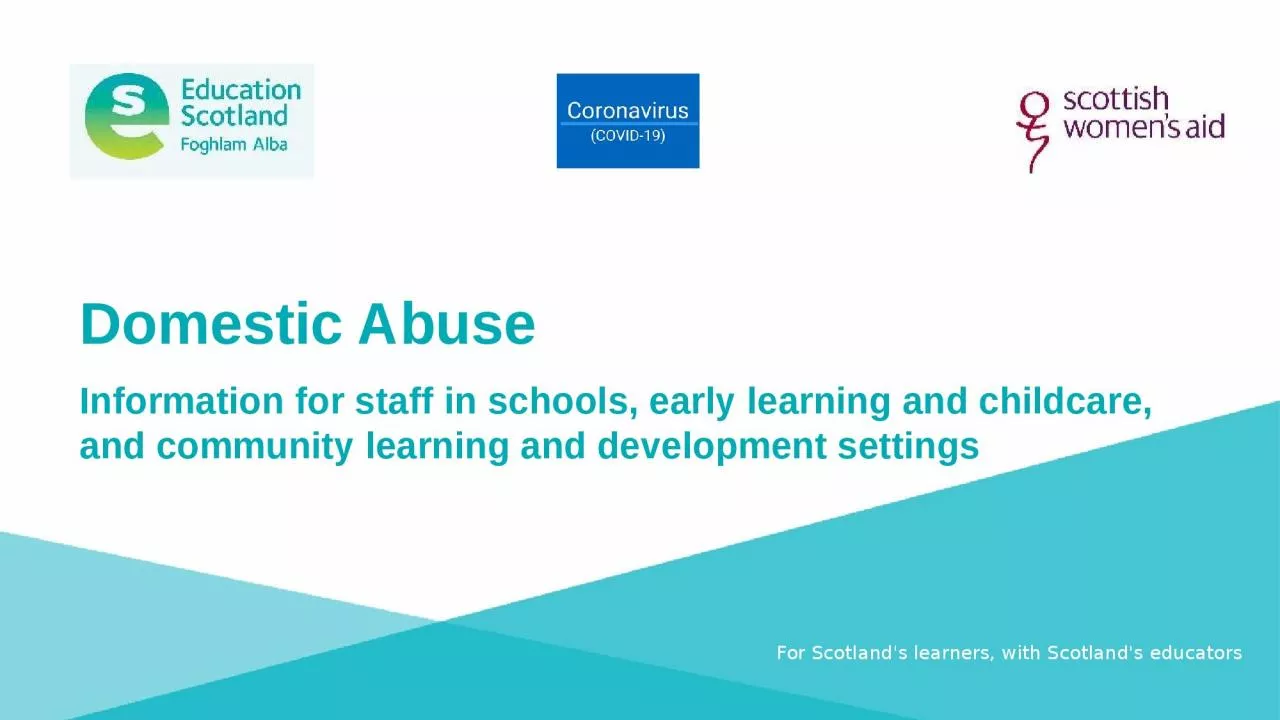

early learning and childcare and community learning and development settings For Scotlands learners with Scotlands educators Welcom e After participating in this learning activity you will have an awareness of ID: 1018880
Download Presentation The PPT/PDF document "Domestic Abuse Information for staff in ..." is the property of its rightful owner. Permission is granted to download and print the materials on this web site for personal, non-commercial use only, and to display it on your personal computer provided you do not modify the materials and that you retain all copyright notices contained in the materials. By downloading content from our website, you accept the terms of this agreement.
1. Domestic AbuseInformation for staff in schools, early learning and childcare, and community learning and development settingsFor Scotland's learners, with Scotland's educators
2. Welcome After participating in this learning activity you will have an awareness of: The nature of domestic abuseThe impact on children and young peopleSigns of abuseThe role of adults in supporting learnersYou will have an opportunity to explore and reflect on the implications for your setting. This presentation aims to support your professional learning. The National Model of Professional Learning
3. Domestic AbuseStatistically at least one child in every class will have experience of domestic abuse. One in 5 children in the UK will have experienced domestic abuse by the time they reach 18.
4. Domestic abuse is a pattern of behaviour that instils fear and is used by abusers to maintain control. It includes any pattern of controlling, bullying, threatening or violent behaviour towards a partner or ex-partner including psychological and emotional abuse (coercive control). What is domestic abuse?
5. Children and young people and domestic abuseChildren and young people can experience domestic abuse:directly from the abuserindirectly via the abuse of their non-abusing parent young people can experience domestic abuse in their own intimate relationships
6. The experience of domestic abuse for children and young peopleViolation of children’s rights
7. The impact of domestic abuse for children and young peopleImpact is not inevitable: supportive adults can make a differenceNegative impact on social relationships, educational achievement and family relationships Mental Wellbeing Increased internalising and externalising difficultiesPost –traumatic stressDifficulty regulating emotionsHigh separation distressFeelings Fear, Powerlessness, Depression or sadness Anger and guiltAnxietyPhysical health – links to obesity, asthma and bodily complaints
8. Activity: Signs of domestic abuse
9. Domestic abuse in teenage relationships6% of reported cases of domestic abuse involved young people under 18 (Scotland 2018-19)The last major survey of abuse in young people’s relationships (2009) found:75% of girls and 50% of boys experienced emotional abuse of some form25% of girls and 18% of boys experienced physical abuse33% of girls and 16% of boys experienced sexual abuseOne in 6 girls reported severe abuse.Abuse in teenage relationships can include the factors already outlined for adults and may also include sexting, requesting or sharing of images, sharing of pornography, sexual coercion and grooming.These behaviours can be considered ‘normal’ in peer groups.
10. It is vital that young people have the opportunity to have a safe space to discuss their experiences to help them identify healthy and unhealthy relationships.This is a film by young people for young people about abuse in relationships.
11. Activity: Responding to disclosures of domestic abuseActivityIn pairs, discuss what you would do if a child or young person disclosed domestic abuse.ConsiderWhat might you say to the child or young person?What you would do next?Read the suggestions on P. 9. What are your child protection guidelines in this situation?What should you do if you have concerns but no one has made a disclosure?
12. What can help?A curriculum and culture that promotes positive relationships and respectMany abused children will not be identified so a nurturing, trauma informed response is crucial for all learnersStaff who are trained and aware (including non-teaching staff)Clear safeguarding policies and guidanceStrong partnerships with local specialist domestic abuse services-for support for children and families and for professional developmentIncluding the views of children and young people who have experienced abuseAwareness raising for learners on keeping safe and seeking help if they don’t feel safe
13. A whole school approach to ending gender-based violenceWhole school approach to ending gender-based violence
14. Domestic abuse and additional support needsThere are a wide range of factors which may lead to some children and young people having a need for additional support. These fall broadly into the four overlapping themes highlighted in the graphic. ActivityConsider what you have learned to date about domestic abuse.What additional support needs might arise?
15. Activity : Responding effectively to domestic abuseFocus – How effective is our response to domestic abuse? Reflection In my class In our learning community In our local authority What I /we do well What needs to improve How to improve This activity can be done individually or with colleagues – make a note of your reflections
16. For Scotland's learners, with Scotland's educatorsScotland’s Domestic abuse and Forced Marriage 24 hour helpline 0800 027 1234